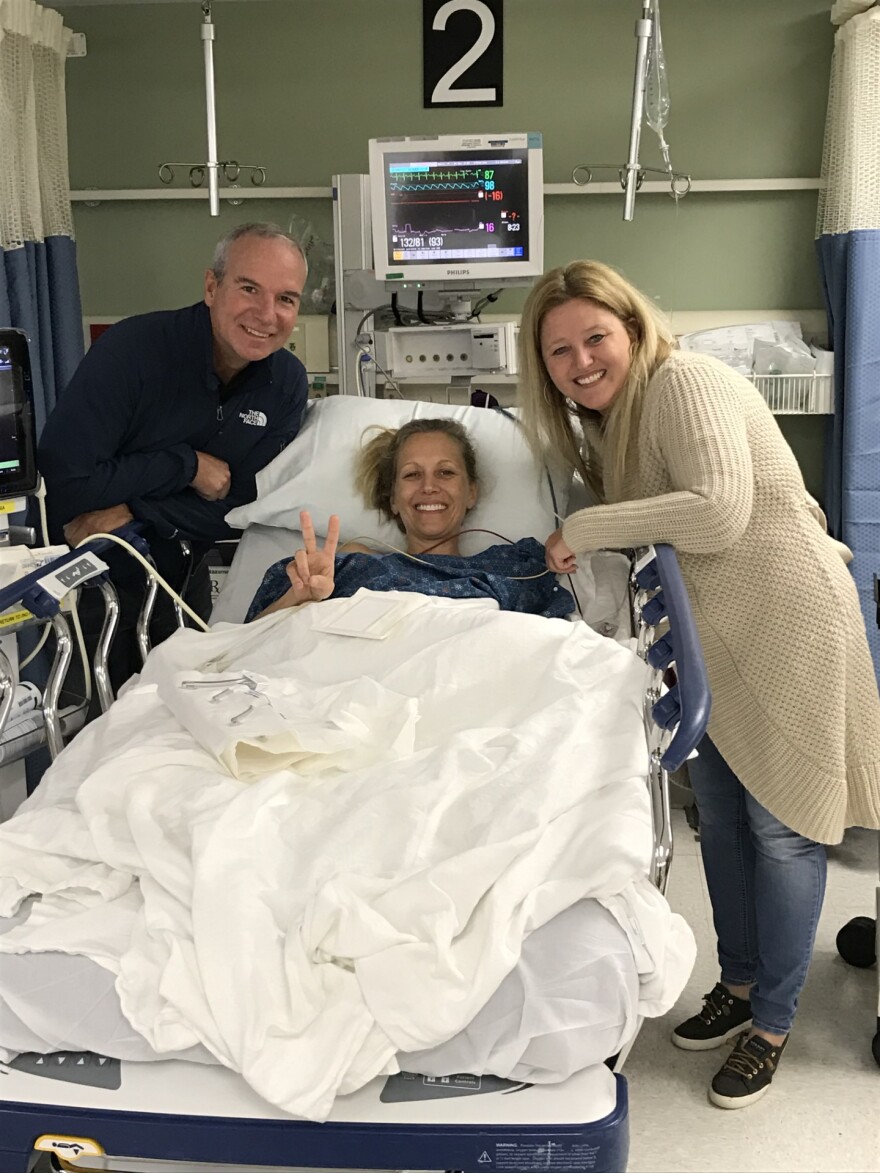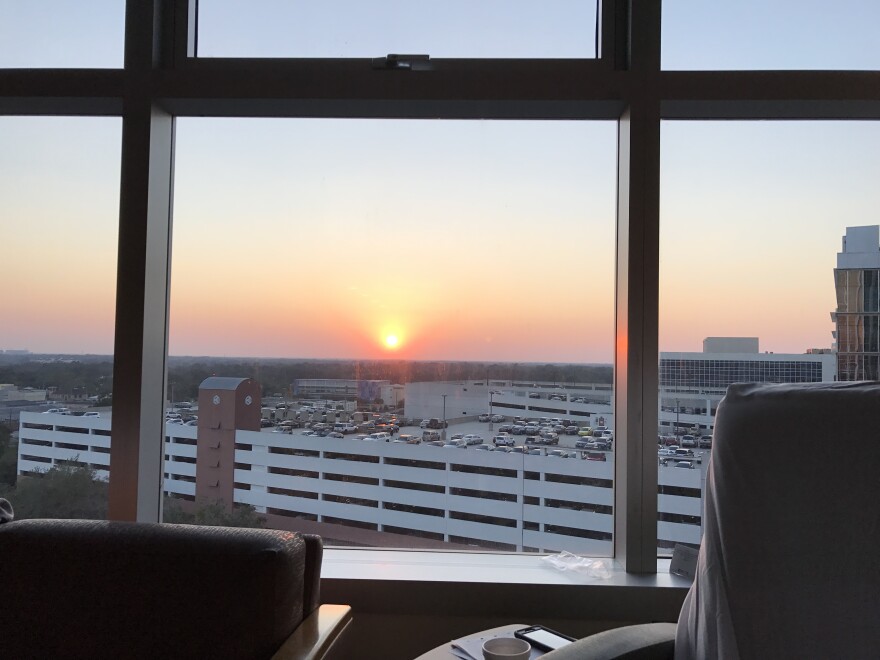Winter Garden resident Jacquee Wahler is a lung cancer survivor. That fact alone stands out. However, what's atypical is that Wahler didn't fit any of the typical signs associated with the disease when diagnosed, nor did she fit the American Cancer Society's updated guidelines for who should receive yearly screenings.
Wahler was 49 years old at the time her lung cancer was first flagged, and a nonsmoker.
“The whole situation happened so quickly that I didn't necessarily have time to pause and contemplate a lot of different things,” she said. “A lot of unanswered questions at that time.”
Questions like, how could a healthy, younger person get cancer?
“I’m pretty active. Running around with the kids and things like that. But, you know, do I drink enough water every day? Probably not. Should I take more vitamins, probably? But I do my very best now as well as before to really focus on my health,” she said.
Wahler’s doctor, Mark Socinski — the medical director of the Central Florida AdventHealth Cancer Institute — has seen plenty of patients in the last 30 years like Wahler who don’t fall in line with the typical diagnosis.
“It's largely because of our understanding of the biology of lung cancer," he said. "One size doesn't fit all.”
New guidelines
Lung cancer remains the deadliest cancer in men and women according to the Centers for Disease Control and Prevention. Despite the amount of case data researchers have, lung cancer still presents many questions.
In November, the cancer society updated and expanded its screening guidelines to include people age 50 to 80 who currently smoke or used to smoke at least 20 packs a year. The U.S. Preventative Task Force made the same recommendation in 2021. Before this most recent change, only people 55 to 74 who smoked at least 30 packs a year were recommended for screening. Those guidelines were established in 2013.
The November change came after significant findings regarding increased case rates for younger women age 35 to 50, according to the American Medical Association. AMA research observed an overall reduction in lung cancer cases, but the reduction was less in women — particularly younger women — than it was in men, who historically observed higher case rates.
Sociniski has noticed that trend in his practice for the past 30 years and thinks the recommendations leave out a misunderstood group of people: nonsmokers.
"Smoking isn't destined to give you lung cancer. Most people who smoke don't get lung cancer. And the question is, why do some people have susceptibility issues? We don't really understand it that well,” Socinski said.
According to the CDC, about 30,000 nonsmokers are diagnosed with cancer every year. That’s about 13 percent of all yearly diagnoses. Lung cancer is still strongly linked to smoking cigarettes, but lung cancer in nonsmokers is prevalent and the seventh leading cause of cancer deaths, according to the National Library of Medicine.
One aspect of lung cancer that experts have come to understand is the role of a specific protein mutation that can be responsible for lung cancer — EGFR (epidermal growth factor receptor) – which can make a cell grow too quickly and cause cancer. The mutation is common in nonsmokers and women.
"They're more common in never-smokers," Socinski said.
Although, it’s not clear why.
Wahler’s “blessing”
After learning of her diagnosis, Wahler turned 50-years-old.
"It was a big year," she said.
Like many cancer patients, she thought about her mortality, and she began talking to her 5-year-old son and 9-year-old daughter about her treatment surgery in November 2016. She promised them she would be OK and home by Thanksgiving.
Still, she couldn’t help but reflect on how she ended up in Central AdventHealth Hospital – a journey that started in California.

Wahler loves skiing on the lake behind her house, tubing and riding jet skis. She loves to be active and is considered a true never-smoker by her doctor.
"(Wahler) was a very healthy woman. She was successful in her career and had everything going for her at the time, and this was a major, major speed bump," Socinski said.
Seven years ago, Wahler was 49 and on a business trip in California. Just before returning home, she suddenly felt ill. Her stomach was hurting and she had trouble eating. Wahler went to an AdventHealth ER in California, where the doctor told her she had a hernia. But there was something else.
“He said, 'I also have seen some kind of spot on your lung, and I won't release you unless you promise me that when you get back to Orlando on Monday you will immediately go and get this looked at,' " Wahler said.
Wahler did just that. A PET scan showed lung cancer in her middle lung lobe. It was a shock. Wahler didn’t fit the screening guidelines, which means the spot could have gone undetected for much longer.
"There was no family history. I didn't necessarily fall into the main categories. And so. no, there was no screening," she said.
According to Socinski, Wahler had an EGFR mutation, but with a stroke of luck and good timing, the medical team made an early diagnosis and began discussing treatment options. A month later, she turned 50 and began talking to her kids about staying positive.
"I had to explain to both of them what was going to happen. I didn't want to make it scary, but also wanted to make sure that they knew I was going to be in the hospital," she said.
Wahler explained she was going to have lung resection surgery — in which the middle lung lobe is removed – and that she would be home for Thanksgiving.
However, there was a complication during the surgery. Wahler’s thoracic duct was nicked. She remained in the hospital for a second surgery to repair the duct. It was a success.
Wahler kept her promise to her kids, leaving the hospital on Thanksgiving.
"I had an amazing Thanksgiving and a lot to be thankful for,” she said.
Wahler remembers crying a lot then.
Mostly tears of gratitude and relief,” Wahler said. “My heart is filled with gratitude for the fact that they caught this. … It was truly a blessing.”
Recounting that blessing has left Wahler feeling obliged to remind people to keep up with their health, whether it’s screenings or appointments.
"I've advised people to be very in touch with their body, and to be on top of all of the appointments that they know that they should be making the time for," she said.

More to learn
Socinski is still in contact with Wahler, who has been keeping up with testing to see if the cancer manifests again. It used to be a process that caused Wahler a lot of stress.
“She seems to be a lot more comfortable with the concept of being cured now,” Socinski said.
Wahler’s story is a reminder to Socinski that there’s still more to learn about lung cancer. He remembers earlier in his career that lung cancer diagnosis was a death sentence.
"Thirty years ago, I was trained to say that when you have advanced lung cancer you may have a treatable disease but you don't have a curable disease," he said. "This is not a death-and-doom discussion anymore."
Now with a better understanding of lung cancer and screenings, the disease is highly treatable in early stages. Socinski hopes in time that guidelines on who should be screened will change – as has our understanding of cancer – as more evidence surfaces.
"Over time, we're going to learn more, and we're going to hopefully be able to identify populations that may be at higher risk of getting lung cancer, and maybe don't have a 20-year history of smoking or are younger patients," he said.
Right now, people between the ages of 50 to 80 years of age, and who show no symptoms of lung cancer (shortness of breath, cough with small amounts of blood) are recommended to receive a screening once a year.
Copyright 2024 WMFE. To see more, visit WMFE.



